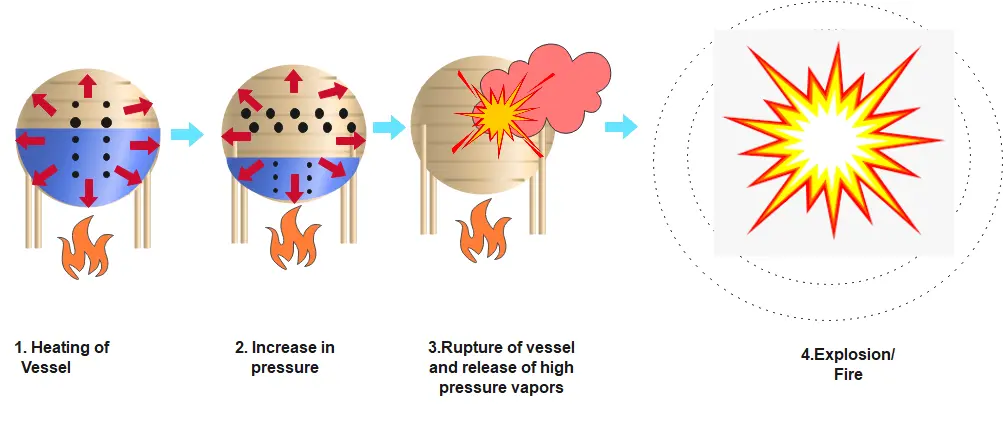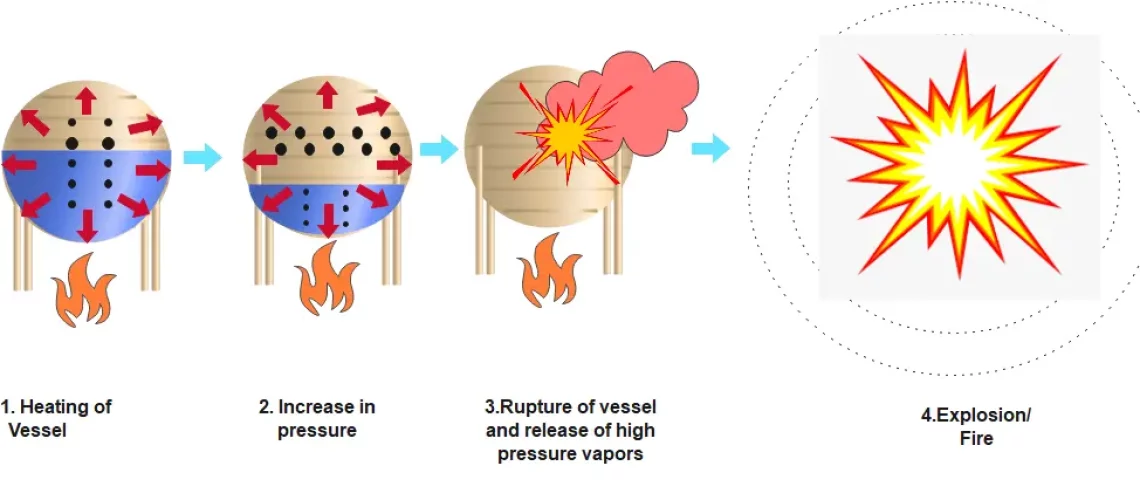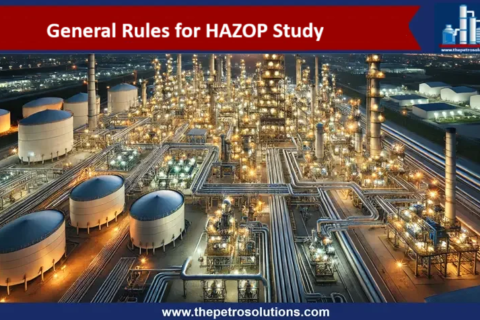Boiling Liquid Expanding Vapor Explosion (BLEVE) is a dangerous and potentially catastrophic event that can occur when a container holding a pressurized and boiling liquid suddenly ruptures, causing the rapid release of the liquid’s vapor. A boiling liquid expanding vapor explosion occurs when a vessel containing a pressurized liquid has reached a temperature significantly above its boiling point. This sudden release of pressure can lead to a violent explosion that can cause significant damage and harm to people and property in the vicinity.
A BLEVE typically occurs when a container, such as a tank or cylinder, is exposed to a heat source that causes the liquid inside to boil and generate vapours, building up pressure inside the container. If the pressure becomes too great, the container may rupture, leading to a sudden release of the vapor and an explosive force that can cause significant damage.
BLEVEs can occur in a variety of settings, including oil refineries, chemical plants, transportation vehicles, and home appliances. But BLEVEs can be particularly dangerous when the boiling liquid is flammable or explosive, such as propane or gasoline. In such cases, the explosion can be extremely powerful and result in a fireball that can cause significant damage to the surrounding area.
To prevent BLEVEs, it is important to ensure that containers holding pressurized and boiling liquids are properly designed, maintained, and operated. Proper safety measures, such as relief valves and pressure gauges, can help prevent the buildup of excessive pressure and reduce the risk of a catastrophic explosion.
Mechanism of BLEVE
A Boiling Liquid Expanding Vapor Explosion (BLEVE) occurs when a container holding a pressurized and boiling liquid suddenly ruptures, causing the rapid release of the liquid’s vapor. The mechanism of a BLEVE can be explained in several stages:
- Heating of the container: The BLEVE mechanism starts with the heating of a container holding a pressurized and boiling liquid. When a container is heated, the liquid inside starts to boil, generating steam and increasing the pressure inside the container.
- Increase in pressure: As the pressure inside the container increases, the structural integrity of the container may be compromised. If the pressure becomes too great, the container may rupture, causing a sudden release of the vapor.
- The rapid expansion of the vapor: When the container ruptures, the pressurized vapor is rapidly released, expanding to fill the surrounding area. This sudden release of pressure and expansion of the vapor can generate a powerful shockwave that can cause significant damage.
- Fire or explosion: In cases where the boiling liquid is flammable or explosive, the sudden release of the vapor can ignite, causing a fire or explosion. This can result in a fireball and significant damage to the surrounding area.

The severity of a BLEVE can depend on several factors, including the size and type of container, the type of boiling liquid, and the conditions of use. Proper safety measures, such as pressure relief valves and emergency response planning, can help reduce the risk of a BLEVE and minimize its impact if one does occur.
Prevention of BLEVE
Preventing Boiling Liquid Expanding Vapor Explosions (BLEVEs) involves several key measures to ensure the safe handling of containers that hold pressurized and boiling liquids. By following these measures, the risk of a BLEVE can be significantly reduced, helping to ensure the safe handling of pressurized and boiling liquids. Here are some of the ways to prevent BLEVEs:
- Proper design and maintenance of containers: BLEVEs can occur when a container holding a boiling liquid is exposed to excessive heat, pressure, or damage. Therefore, it is essential to design and maintain these containers to withstand the anticipated conditions of use and prevent leaks, cracks, or other structural damage.
- Safe storage and handling: Proper storage and handling of containers can also help prevent BLEVEs. This includes keeping the containers away from heat sources, ensuring they are stored on a stable surface, and using appropriate handling equipment to prevent drops, impacts, or other accidents.
- Pressure relief systems: Pressure relief systems, such as pressure relief valves or rupture disks, can help prevent the buildup of excessive pressure in the container, which can lead to a BLEVE. These systems are designed to release the pressure safely and prevent the container from rupturing.
- Emergency response planning: In case of a BLEVE, it is important to have an emergency response plan in place. This plan should include procedures for evacuating the area, shutting off the fuel source, and contacting emergency services.
- Proper training and education: Proper training and education of employees and workers involved in handling pressurized and boiling liquids can also help prevent BLEVEs. Workers should be trained on the safe handling, storage, and transport of these liquids, as well as emergency response procedures.
Largest BLEVE Explosion in History
The largest BLEVE explosion in history occurred in Mexico City on November 19, 1984. A series of explosions at a liquid propane gas (LPG) storage facility caused a massive fire and subsequent BLEVE, which destroyed several nearby neighbourhoods and resulted in the deaths of at least 200 people.
The explosion occurred at the San Juanico LPG storage facility, which was one of the largest in the world at the time. A gas leak occurred at one of the storage tanks, which led to a fire that spread rapidly to other tanks. Eventually, the heat caused one of the tanks to rupture, leading to a massive BLEVE that sent a fireball and shockwave through the surrounding area.
The explosion and resulting fire destroyed thousands of homes and businesses and caused millions of dollars in damage. Emergency responders were overwhelmed, and the incident is considered one of the worst industrial disasters in history.
Difference Between BLEVE and VCE:
A Boiling Liquid Expanding Vapor Explosion (BLEVE) and a Vapor Cloud Explosion (VCE) are both types of explosions that can occur when pressurized gases are released suddenly. However, there are some differences between the two:
- BLEVEs occur when a container holding a pressurized liquid is exposed to heat or a sudden drop in pressure, causing the liquid to rapidly boil and expand into a vapor. If the pressure builds up to a critical point, the container can rupture, causing a violent explosion. In contrast, a VCE occurs when a cloud of flammable gas or vapor is ignited, causing a rapid release of energy that can result in a powerful explosion.
- BLEVEs are typically associated with pressurized vessels used to store liquefied gases such as propane, butane, or ammonia, whereas VCEs typically involve gases that are released into the air, such as natural gas or gasoline vapours.
- BLEVEs typically occur in confined spaces, such as storage tanks or pipelines, whereas VCEs can occur in both confined and open spaces.
- In a BLEVE, the initial explosion is caused by the sudden release of pressure and energy from the ruptured container. In a VCE, the explosion is caused by the ignition of a flammable gas or vapor cloud.
Both types of explosions can be extremely dangerous and can cause significant damage and loss of life. It is important to take proper precautions and safety measures when handling and storing pressurized gases and to have emergency response plans in place in case of an accident.
Top References:
- Guidelines for Vapor Cloud Explosion, Pressure Vessel Burst, BLEVE, and Flash Fire Hazards
- https://www.isrmag.com
For further information, discussion and queries please comment in the box below or contact us at admin@ or follow us on Facebook & LinkedIn.
Certified Functional Safety Professional (FSP, TÜV SÜD), Certified HAZOP & PHA Leader, LOPA Practitioner, and Specialist in SIL Verification & Functional Safety Lifecycle, with 18 years of professional experience in Plant Operations and Process Safety across Petroleum Refining and Fertilizer Complexes.
- Nasir Hussainhttps://thepetrosolutions.com/author/admin/
- Nasir Hussainhttps://thepetrosolutions.com/author/admin/
- Nasir Hussainhttps://thepetrosolutions.com/author/admin/
- Nasir Hussainhttps://thepetrosolutions.com/author/admin/






